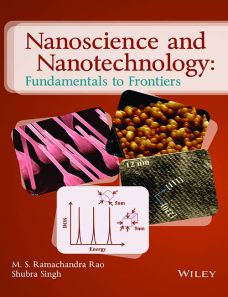Nanoscience and Nanotechnology: Fundamentals of Frontiers
ISBN: 9788126542017
388 pages
eBook also available for institutional users
For more information write to us at: acadmktg@wiley.com

Description
Nanoscience and nanotechnology are evolving at a rapid pace and there have been a number of scientific and technological advancements in these fields in recent times. This book explains scientific foundations governing the functionality of nanostructures and makes the reader familiar with several basic and application aspects of nano-structured systems. This book is designed as a Nanoscience and Nanotechnology course text book that could be offered by Physics, Materials Science and Nanoscience streams in various core departments and nanotechnology centers and other related departments in universities, institutes and colleges.
1. The Science behind Nanotechnology
1.1 History of Nanoscience
1.2 Definition of Nanometer, Nanomaterial, and Nanotechnology
1.3 Classification of Nanomaterial
1.4 Nanotechnology from the Perspective of Medieval Period
2. Concepts of Solid-State Physics Relevant to Low-Dimensional Systems
2.1 Introduction
2.2 Crystal Symmetries, Crystal Directions, and Crystal Planes
2.3 Band Structure
2.4 Classification of Solid-State Materials
2.5 Bulk Properties of Materials
2.6 Magnetic Materials
2.7 Effect of Size Reduction on Bulk Properties
2.8 Optoelectronic Property of Bulk and Nanostructures
2.9 Electronic Structure of Nanomaterial and the Fermi Surface
2.10 Luminescence from Nanoparticles
2.11 Raman Spectroscopy of Nanoparticles
2.12 Thermodynamics of Nanomaterial: Change in Melting Point
3. Quantum Mechanics of Low-Dimensional Systems and Its Application to Nanoscience
3.1 Introduction
3.2 Energy Considerations: Bound States and Density of States
3.3 Quantum Confinement
3.4 Super lattices
3.5 Band Offsets
3.6 Quantum Transport in Nano clusters /Quantum Dots
4. Basic Aspects of Synthesis of Nanomaterial and Device Fabrication
4.1 Introduction
4.2 Synthesis of Bulk Polycrystalline Samples
4.3 Growth of Single Crystals
4.4 Synthesis Techniques for the Preparation of Nanoparticles
4.5 Requirements for Realizing Semiconductor Nanostructures
4.6 Some Specialized Growth Techniques for Nanostructures
4.7 Electrostatic-Induced Growth
4.8 Thermally Annealed Quantum Wells
4.9 Semiconductor Nano crystals
5. Different Types of Nanostructures
5.1 Introduction
5.2 Shapes and Structures of Nanomaterial
5.3 Quantum Dots
5.4 Semiconductor Nanoparticles
6. Diffusion Kinetics
6.1 Introduction
6.2 Thermodynamics of Diffusion
6.3 Grain Boundary Effect
6.4 Effect of Defects on Diffusion
7. Nanostructured Thin Films and Nano composites
7.1 Introduction
7.2 Micro- and Nano scale Thin-Film Fabrication Techniques
7.3 Optical, Electrical, and Magnetic Properties of Nanostructured
Thin Films
7.4 Nano composites
7.5 Physical and Optical Properties
7.6 Metal/Dielectric-Organic Nano composites
8. Nano scale Characterization Techniques
8.1 Introduction
8.2 X-Ray Diffraction and Scherer Method
8.3 Scanning Electron Microscopy
8.4 Transmission Electron Microscopy
8.5 Stoichiometry Study by Energy-Dispersive X-Ray Analysis
8.6 Scanning Probe Microscopy
8.7 Atomic Force Microscopy
8.8 Piezoresponse Microscopy
8.9 X-Ray Photoelectron Spectroscopy
8.10 XANES and XAFS
8.11 Angle-Resolved Photoemission Spectroscopy
8.12 Diffuse Reflectance Spectra
8.13 Photoluminescence Spectra
8.14 Raman Spectroscopy
8.15 DC Magnetization
8.16 Electrical Resistivity Measurements
8.17 Theory of Linear Four-Probe Method
9. Recent Advances in Nanotechnology
9.1 Introduction
9.2 Designing Molecules for Nano electronics
9.3 Advances of Nanotechnology in Materials Science
10. New Trends in Nanoscience and Applications of Nanotechnology in Various Fields
10.1 Introduction
10.2 Applications in Material Science
10.3 Applications in Biology and Medicine
10.4 Applications in Surface Science
10.5 Applications in Energy and Environment
10.6 Applications of Nanostructured Thin Films
10.7 Applications of Quantum Dots
10.8 Carbon Nanotechnology
10.9 Applications of Magnetic Nanoparticles
Appendix A - Useful Lab Experiments
Appendix B - Useful Tables
Index

